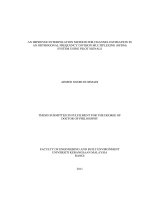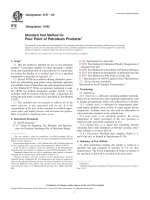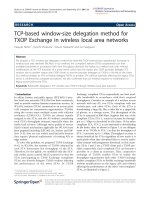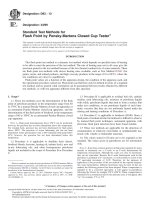Standard Test Method for Naphthalene Hydrocarbons in Aviation Turbine Fuels by Ultraviolet Spectrophotometry
Bạn đang xem bản rút gọn của tài liệu. Xem và tải ngay bản đầy đủ của tài liệu tại đây (84.65 KB, 4 trang )
This international standard was developed in accordance with internationally recognized principles on standardization established in the Decision on Principles for the
Development of International Standards, Guides and Recommendations issued by the World Trade Organization Technical Barriers to Trade (TBT) Committee.
Designation: D1840 − 07 (Reapproved 2017)
Standard Test Method for
Naphthalene Hydrocarbons in Aviation Turbine Fuels by
Ultraviolet Spectrophotometry1
This standard is issued under the fixed designation D1840; the number immediately following the designation indicates the year of
original adoption or, in the case of revision, the year of last revision. A number in parentheses indicates the year of last reapproval. A
superscript epsilon (´) indicates an editorial change since the last revision or reapproval.
This standard has been approved for use by agencies of the U.S. Department of Defense.
1. Scope
1.1 This test method covers the determination, by ultraviolet
spectrophotometry, of the total concentration of naphthalene,
acenaphthene, and alkylated derivatives of these hydrocarbons
in jet fuels. This test method is designed to analyze fuels
containing not more than 5 % of such components and having
end points below 315 °C (600 °F); however, the range of
concentrations used in the interlaboratory test programs which
established the precision statements for this test method were
0.03 % to 4.25 % by volume for Procedure A, and 0.08 % to
5.6 % by volume for Procedure B. This test method determines
the maximum amount of naphthalenes that could be present.
1.2 The values stated in SI units are to be regarded as
standard. No other units of measurement are included in this
standard.
1.3 This standard does not purport to address all of the
safety concerns, if any, associated with its use. It is the
responsibility of the user of this standard to establish appropriate safety, health, and environmental practices and determine the applicability of regulatory limitations prior to use.
For specific warning statements, see 8.1 and 8.2.
1.4 This international standard was developed in accordance with internationally recognized principles on standardization established in the Decision on Principles for the
Development of International Standards, Guides and Recommendations issued by the World Trade Organization Technical
Barriers to Trade (TBT) Committee.
2. Referenced Documents
2.1 ASTM Standards:2
E131 Terminology Relating to Molecular Spectroscopy
E169 Practices for General Techniques of Ultraviolet-Visible
Quantitative Analysis
E275 Practice for Describing and Measuring Performance of
Ultraviolet and Visible Spectrophotometers
3. Terminology
3.1 Definitions:
3.1.1 Definitions of terms and symbols relating to absorption spectroscopy in this test method shall conform to Terminology E131. Terms of particular significance are the following:
3.1.2 radiant energy, n—energy transmitted as electromagnetic waves.
3.1.3 radiant power, P, n—rate at which energy is transported in a beam of radiant energy.
3.2 Definitions of Terms Specific to This Standard:
3.2.1 absorbance, A, n—the molecular property of a substance that determines its ability to take up radiant power,
expressed by
A 5 log10 ~ 1/T ! 5 2log10T
where:
T = transmittance as defined in 3.2.5.
3.2.1.1 Discussion—It may be necessary to correct the
observed transmittance (indicated by the spectrophotometer)
by compensating for reflectance losses, solvent absorption
losses, or refraction effects.
3.2.2 absorptivity, a, n—the specific property of a substance
to absorb radiant power per unit sample concentration and path
length, expressed by
a 5 A/bc
1
This test method is under the jurisdiction of ASTM Committee D02 on
Petroleum Products, Liquid Fuels, and Lubricants and is the direct responsibility of
Subcommittee D02.04.0F on Absorption Spectroscopic Methods.
Current edition approved Oct. 1, 2017. Published November 2017. Originally
approved in 1961. Last previous edition approved in 2013 as D1840 – 07 (2013).
DOI: 10.1520/D1840-07R17.
2
For referenced ASTM standards, visit the ASTM website, www.astm.org, or
contact ASTM Customer Service at For Annual Book of ASTM
Standards volume information, refer to the standard’s Document Summary page on
the ASTM website.
(1)
(2)
where:
A = absorbance defined in 3.2.1,
b
= sample cell path length, and
c
= quantity of absorbing substance contained in a unit
volume of solvent.
3.2.2.1 Discussion—Quantitative ultraviolet analyses are
based upon the absorption law, known as Beer’s law. The law
Copyright © ASTM International, 100 Barr Harbor Drive, PO Box C700, West Conshohocken, PA 19428-2959. United States
Copyright by ASTM Int'l (all rights reserved); Tue Nov 21 07:51:57 EST 2017
1
Downloaded/printed by
Nanyang Technological University (Nanyang Technological University) pursuant to License Agreement. No further reproductions authorized.
D1840 − 07 (2017)
states that the absorbance of a homogeneous sample containing
an absorbing substance is directly proportional to the concentration of the absorbing substance at a single wavelength,
expressed by
A 5 abc
(3)
where:
A = absorbance as defined in 3.2.1,
a = absorptivity as defined in 3.2.2,
b = sample cell path length, and
c = quantity of absorbing substance contained in a unit
volume of solvent.
3.2.3 concentration, c, n—the quantity of naphthalene hydrocarbons in grams per litre of isooctane.
3.2.4 sample cell path length, b, n—the distance, in
centimetres, measured in the direction of propagation of the
beam of radiant energy, between the surfaces of the specimen
on which the radiant energy is incident and the surface of the
specimen from which it is emergent.
3.2.4.1 Discussion—This distance does not include the
thickness of the cell in which the specimen is contained.
3.2.5 transmittance, T, n—the molecular property of a substance that determines its transportability of radiant power
expressed by
T 5 P/P o
(4)
where:
P = radiant power passing through the sample, and
Po = radiant power incident upon the sample.
4. Summary of Test Method
4.1 The total concentration of naphthalenes in jet fuels is
determined by measurement of the absorbance at 285 nm of a
solution of the fuel at known concentration.
5. Significance and Use
5.1 This test method for naphthalene hydrocarbons is one of
a group of tests used to assess the combustion characteristics of
aviation turbine fuels of the kerosene boiling range. The
naphthalene hydrocarbon content is determined because
naphthalenes, when burned, tend to have a relatively larger
contribution to a sooty flame, smoke, and thermal radiation
than single ring aromatics.
6. Interferences
6.1 Interferences add to the apparent naphthalene content.
Phenanthrenes,
dibenzothiophenes,
biphenyls,
benzothiophenes, and anthracenes interfere if present. The end
point limitation of 315 °C will minimize this interference
except for benzothiophenes and biphenyls. The contribution to
measured naphthalene content by the presence of 1 % of such
interfering compounds can be estimated from Table 1.
6.2 Saturated hydrocarbons, olefins, thiophenes, and alkyl
or cycloalkyl derivatives of benzene will not interfere.
7. Apparatus
7.1 Spectrophotometer, equipped to measure the absorbance
of solutions in the spectral region 240 nm to 300 nm with a
TABLE 1 Interfering Compounds
Type of Interfering Compound
Error in Percentage of
Naphthalenes Caused by 1 %
Interfering Compound
Phenanthrenes
Dibenzothiophenes
Biphenyls
Benzothiophenes
Anthracenes
2
2
1
0.6
0.1
spectral slit width of 1 nm or less. Wavelength measurements
shall be repeatable and known to be accurate within 0.1 nm or
less as measured by mercury emission line at 253.65 nm or the
absorption spectrum of either holmium oxide glass at 287.5 nm
or holmium oxide solution at 287.1 nm. At the 0.4 absorbance
level in the spectral region between 240 nm and 300 nm, absorbance measurements shall be repeatable within 60.5 % or
better. In the absorbance range encompassing 0.2 to 0.8, the
photometric accuracy shall not differ by more than 60.5 % of
samples whose absorbance has been established by a standardizing laboratory.
7.1.1 Discussion—Many manufacturers provide secondary
standards, traceable to NIST primary standards, for checking
the wavelength accuracy and photometric accuracy of spectrophotometers. These materials may be used to verify spectrophotometer performance provided that they have been recalibrated periodically as recommended by the manufacturer.
7.2 It shall be initially and thereafter periodically demonstrated that an instrument can be operated in a manner to give
test results equivalent to those described in 7.1.
NOTE 1—For recommended methods of testing spectrophotometers to
be used in this test method, refer to Practice E275. Other preferred
alternatives to those in 7.1 are potassium dichromate in perchloric acid
(NIST SRM 935 series as described in Practice E275) for photometric
accuracy and a 20 mg ⁄L high (>99 %) purity naphthalene in spectroscopic
grade isooctane for wavelength accuracy. The latter has a minor maximum
at 285.7 nm. The naphthalene solution shall not be used for photometric
accuracy.
7.3 Vitreous Silica Cells, two, having path lengths of
1.00 cm 6 0.005 cm.
7.4 Pipets, Class A.
7.5 Lens Paper.
7.6 Balance, capable of taring or weighing 100 g to the
nearest 0.0001 g. The balance shall be accurate to 60.0002 g at
a 100 g load.
8. Solvents
8.1 Spectroscopic 2,2,4 Trimethylpentane (Isooctane).
(Warning—Isooctane is extremely flammable, harmful if inhaled.)
NOTE 2—Spectroscopic-grade isooctane is available commercially.
Technical-grade isooctane is a satisfactory base stock for the preparation
of spectroscopic solvent. Allow about 4 L or 5 L of this material to
percolate through a column of activated silica gel (74 µm) 50.8 mm to
76.2 mm in diameter and 0.6 m to 0.9 m in depth. Collect only the portion
of the solvent that has a transmission compared to distilled water greater
than 90 % over the entire spectral range from 240 nm to 300 nm. Store in
scrupulously clean glass-stoppered bottles and always keep covered. In
general it will be best to use a fresh portion of silica gel in preparing a new
Copyright by ASTM Int'l (all rights reserved); Tue Nov 21 07:51:57 EST 2017
2
Downloaded/printed by
Nanyang Technological University (Nanyang Technological University) pursuant to License Agreement. No further reproductions authorized.
D1840 − 07 (2017)
batch of solvent. However the gel can be reactivated by pouring 500 mL
of acetone through the column, draining, drying by suction, and heating
the gel in thin layers in an oven at 400 °C until white color is restored.
Activated silica gel is stored in closed containers.
8.2 Solvents for Cleaning Cells—Acetone or ethyl alcohol
(Warning—Acetone and ethyl alcohol are extremely flammable and can be harmful if inhaled), with residue after
evaporation no greater than 10 mg ⁄kg.
NOTE 3—The 10 mg ⁄kg is the American Chemical Society (ACS)
reagent grade maximum specification. An ACS reagent grade solvent may
be used without further testing.
9. Calibration and Standardization
9.1 Instead of direct calibration of the spectrophotometer
with known naphthalenes, the average absorptivity of the C10
to C13 naphthalenes at 285 nm can be taken at 33.7 L ⁄g·cm.
The data used to calculate this average are given in Table 2.
10. Procedure A—Serial Dilution
NOTE 4—The user may use alternative Procedure B if preferred.
10.1 For recommended techniques, refer to Practices E169.
Check carefully sections on handling and cleaning of cells and
glassware, instrument adjustments, and method of absorbance
measurement.
10.2 Prepare three dilutions of the sample as follows:
10.2.1 First Dilution—If the sample is more volatile than
isooctane, add 10 mL to 15 mL of spectroscopic isooctane to a
clean, dry, glass-stoppered, 25 mL volumetric flask. Weigh out
approximately 1 g of sample in the flask, dilute to volume with
spectroscopic solvent, and mix thoroughly. If the sample is less
volatile than isooctane, weigh out approximately 1 g of sample
in the flask, dilute to volume with spectroscopic solvent, and
mix thoroughly.
10.2.2 Second Dilution—Pipet 5.00 mL of the first dilution
into a 50 mL glass-stoppered volumetric flask, dilute to volume
with spectroscopic isooctane, and mix thoroughly.
10.2.3 Third Dilution—Dilute 5.00 mL of second dilution to
50 mL in the same manner as in 10.2.2.
10.3 Determination of Cell Correction—Measure and record the absorbance of the spectroscopic isooctane-filled
sample cell as compared to the spectroscopic isooctane-filled
solvent cell.
10.4 Measurement of Absorbance—Transfer portions of the
final dilution into the sample cell of the spectrophotometer.
Cover the cells immediately to prevent transfer of aromatic
hydrocarbons from the sample cell to the solvent cell. Check
the windows of the absorption cells and make certain they are
clean. Measure the absorbance as recommended in Practices
E169. Record the absorbance of the sample as compared to
spectroscopic isooctane at 285 nm.
NOTE 5—The dilution of the sample should be controlled so that
absorbance readings fall within a range of 0.2 to 0.8 for maximum
reproducibility of results. To accomplish this it may be necessary to use an
alternative third dilution than the one specified in 10.2.3, such as 10 mL
of the second dilution to 25 mL with solvent.
11. Procedure B—Alternative 100 mL Dilution
11.1 Discussion—The incorporation of the single dilution
procedure has been included as an alternative procedure to
reduce: test time, glassware, cleaning, and dilution errors.
11.2 For recommended techniques, refer to Practices E169.
Check carefully sections on handling and cleaning of cells and
glassware, instrument adjustments, and method of absorbance
measurement.
11.3 Sample Preparation—Add an appropriate mass of
sample to a clean, dry, tared 100 mL volumetric flask. Record
the mass to the nearest 0.0001 g. Dilute to the mark with
spectroscopic grade isooctane, stopper, and mix thoroughly.
11.3.1 Refer to Table 3 for lists of sample masses associated
with naphthalene(s) concentrations that give 0.2 to 0.8 absorbance readings as directed in Note 7. A 60 mg sample will be
appropriate for typical jet fuels in the range of 0.8 % to 3.0 %
by volume naphthalenes.
NOTE 6—A micropipette is a convenient tool for adding an appropriate
volume. If the fuel density is not known at the time of sample preparation,
use 0.8 as an approximation.
11.4 Determination of Cell Correction—Proceed as written
in 10.3.
11.5 Measurement of Absorbance—Proceed as written in
10.4.
12. Calculations
12.1 Calculate the mass percentage of naphthalenes in the
sample as follows:
Naphthalenes, mass % 5 @ ~ A 3 K ! / ~ 33.7 3 W ! # 3 100
(5)
TABLE 2 Data Issued by API Research Project 44
Compound
Naphthalene
1-methyl Naphthalene
2-methyl Naphthalene
1,2-dimethyl Naphthalene
1,3-dimethyl Naphthalene
1,4-dimethyl Naphthalene
1,5-dimethyl Naphthalene
1,6-dimethyl Naphthalene
1,7-dimethyl Naphthalene
1,8-dimethyl Naphthalene
2,3-dimethyl Naphthalene
2,6-dimethyl Naphthalene
2,7-dimethyl Naphthalene
1-isopropyl Naphthalene
API Serial
Number
L/g·cm
605
539
572
215
216
217
218
219
220
221
222
226
224
203
28.5
32.0
22.9
37.3
36.4
43.5
54.0
36.4
36.0
46.0
22.0
21.3
23.5
31.7
TABLE 3 Estimated Sample Mass and Volume to Take for the
Volume % Naphthalene Content of the Sample in the Single
Dilution Procedure to Keep the Absorption Values Between 0.2
and 0.8 Units (Assuming a Density of 0.8)
Sample
Volume
(mL)
Sample
Mass
(mg)
Volume % Naphthalenes
for Expected
Absorbance
of 0.2 units
Volume % Naphthalenes
for Expected
Absorbance
of 0.8 units
0.050
0.075
0.100
0.150
0.200
0.300
40
60
80
120
160
240
1.2
0.8
0.6
0.4
0.3
0.2
4.8
3.2
2.4
1.6
1.2
0.8
Copyright by ASTM Int'l (all rights reserved); Tue Nov 21 07:51:57 EST 2017
3
Downloaded/printed by
Nanyang Technological University (Nanyang Technological University) pursuant to License Agreement. No further reproductions authorized.
D1840 − 07 (2017)
where:
A = corrected absorbance (observed absorbance minus cell
correction) of the dilution measured,
For Procedure A in Section 10 using serial dilutions,
K = equivalent volume of solvent, in litres, if the dilution
had been made in a single step. For the first dilution
K = 0.025, for the second dilution K = 0.25, for the third
dilution K = 2.5. For the suggested alternative third
dilution K = 0.625,
For Procedure B in Section 11 using 100 mL dilution,
K
= 0.10,
W
= grams of sample used, and
33.7 = the average absorptivity of C10 to C13 naphthalenes in
litres per gram-centimetre.
12.2 Calculate the volume percentage of naphthalenes as
follows:
Naphthalenes, volume % 5 M 3 ~ B/C !
(6)
where:
M = percentage of naphthalenes by mass,
B = relative density of the total fuel (15 °C ⁄15 °C), and
C = relative
density
of
the
naphthalenes
(15 °C ⁄15 °C) = 1.00.
results. The precision for Procedure A was determined based
on examination of interlaboratory test results for samples
covering the range from 0.03 % to 4.25 % by volume naphthalenes. The precision for Procedure B was determined based
on examination of interlaboratory test results for samples
covering the range from 0.08 % to 5.6 % by volume naphthalenes. The precisions are as follows:
15.1.1 Repeatability—The difference between successive
test results obtained by the same operator with the same
apparatus under constant operating conditions on identical test
materials would, in the long run, in the normal and correct
operation of the test method exceed the following values only
in one case in twenty.
Repeatability for Procedure A 5 0.0222 ~ 1.001X !
Repeatability for Procedure B 5 0.056 X
0.6
15.1.2 Reproducibility—The difference between two single
and independent results obtained by different operators working in different laboratories on identical test material would, in
the long run, in the normal and correct operation of the test
method exceed the following values only in one case in twenty.
Reproducibility for Procedure B 5 0.094 X
13.1 Report numerical values of volume percent naphthalene to the nearest 0.01 %.
14. Reference Spectra
14.1 Absorptivities of individual naphthalene hydrocarbons
at 285 nm are derived from data in the API catalog of
ultraviolet spectral data issued by Research Project 44 as given
in Table 2.
NOTE 7—The arithmetic average of the above absorptivities is 33.7. The
reliability of the average absorptivity as a measure of selected individual
naphthalenes can be estimated from the above table.
15. Precision and Bias
15.1 Precision3,4—The precision of this test method was
determined by the statistical examination of interlaboratory test
3
Supporting data for Procedure A (Section 10) have been filed at ASTM
International Headquarters and may be obtained by requesting Research Report
RR:D02-1375.
(8)
where:
X = average of two results, volume %.
Reproducibility for Procedure A 5 0.0299 ~ 1.001X !
13. Report
(7)
0.6
(9)
(10)
where:
X = average of two results, volume %.
NOTE 8—Instruments not conforming to the equipment specifications in
7.1 can result in much poorer precision.
15.2 Bias—Bias cannot be determined for the procedure in
this test method for measuring naphthalene hydrocarbon because the absorptivity will vary with composition of the
individual naphthalene derivatives in samples.
16. Keywords
16.1 aviation turbine fuels; naphthalene hydrocarbons; ultraviolet spectrophotometry
4
Supporting data for Procedure B (Section 11) have been filed at ASTM
International Headquarters and may be obtained by requesting Research Report
RR:D02-1525.
ASTM International takes no position respecting the validity of any patent rights asserted in connection with any item mentioned
in this standard. Users of this standard are expressly advised that determination of the validity of any such patent rights, and the risk
of infringement of such rights, are entirely their own responsibility.
This standard is subject to revision at any time by the responsible technical committee and must be reviewed every five years and
if not revised, either reapproved or withdrawn. Your comments are invited either for revision of this standard or for additional standards
and should be addressed to ASTM International Headquarters. Your comments will receive careful consideration at a meeting of the
responsible technical committee, which you may attend. If you feel that your comments have not received a fair hearing you should
make your views known to the ASTM Committee on Standards, at the address shown below.
This standard is copyrighted by ASTM International, 100 Barr Harbor Drive, PO Box C700, West Conshohocken, PA 19428-2959,
United States. Individual reprints (single or multiple copies) of this standard may be obtained by contacting ASTM at the above
address or at 610-832-9585 (phone), 610-832-9555 (fax), or (e-mail); or through the ASTM website
(www.astm.org). Permission rights to photocopy the standard may also be secured from the Copyright Clearance Center, 222
Rosewood Drive, Danvers, MA 01923, Tel: (978) 646-2600; />
Copyright by ASTM Int'l (all rights reserved); Tue Nov 21 07:51:57 EST 2017
4
Downloaded/printed by
Nanyang Technological University (Nanyang Technological University) pursuant to License Agreement. No further reproductions authorized.


![Standard Test Method for Compressive Strength of Hydraulic Cement Mortars (Using 2-in. or [50-mm] Cube Specimens)](https://media.store123doc.com/images/document/14/rc/yi/medium_yil1395845738.jpg)






